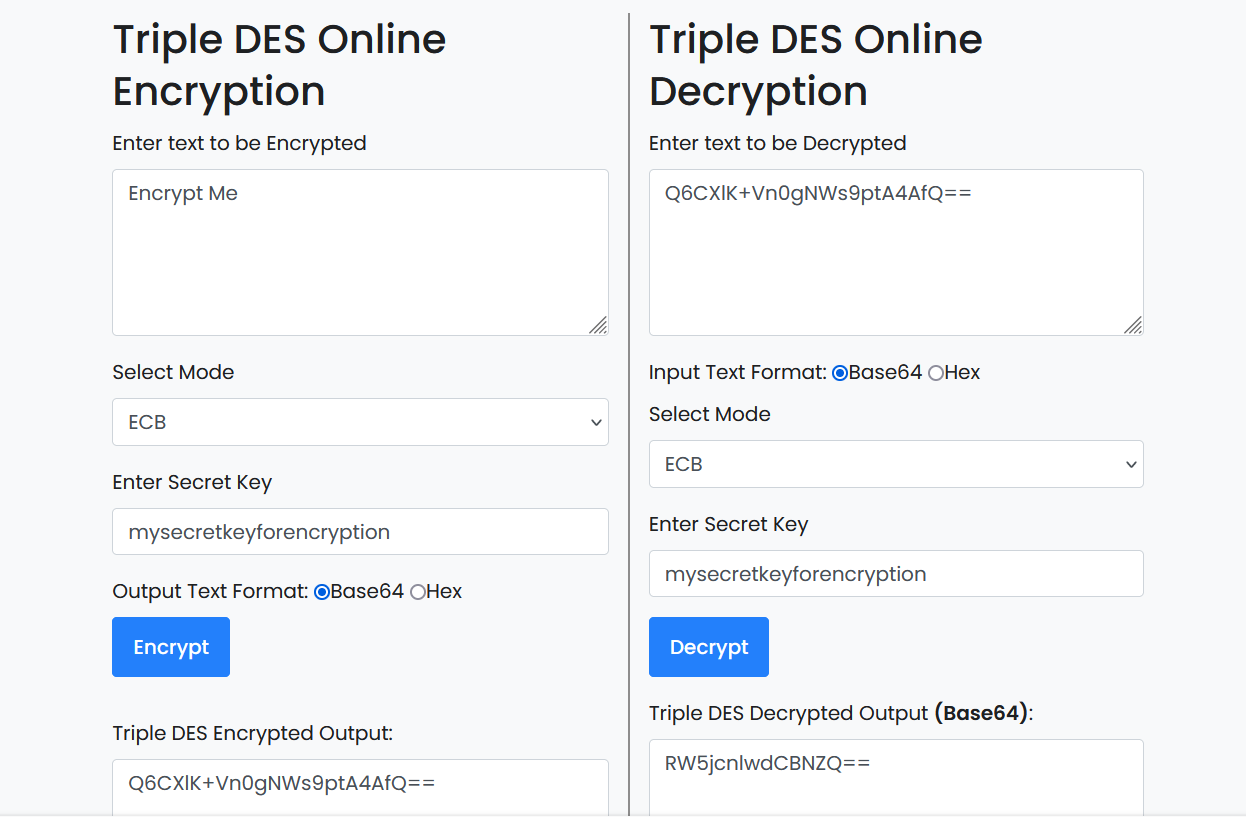Triple DES or DESede ,
a symmetric-key algorithm for the encryption of electronic data, is the successor of
DES(Data
Encryption Standard)
and provides more secure encryption than DES. The Triple DES breaks the
user-provided key into three subways as k1, k2, and k3.
A message is encrypted with k1 first, then decrypted with k2 and encrypted again
with k3. The DESede key size is 128 or 192 bit and
blocks size 64 bit. There are 2 modes of operation—Triple ECB (Electronic Code Book)
and Triple CBC (Cipher Block Chaining).
Below is the online free tool that provides triple DES encryption and decryption with
the two modes of operation for any plain text.
Support This Free Tool!
I build these tools to give you fast, secure, privacy-friendly utilities—free and
signup-free.
Buying me a coffee helps keep the project running and supports
new features.
Thank you for helping this tool thrive!
We do not store, log any key you enter. This tool runs entirely over
a secure HTTPS
connection to keep your encryption key safe at all times.
Triple DES Encryption
- Key Selection:Triple DES uses three keys, typically referred to
as K1, k2, k3. Each key is 56 bits long, but due to parity bits, the effective
key size is 64 bits per key.
- Encryption Process::
- Encrypt with K1The plaintext block is first encrypted
using the first key K1, resulting in ciphertext C1
- Decrypt with K2:C1 is then decrypted using the second
key K2, producing an intermediate result.
- Encrypt with K3:Finally, the intermediate result is
encrypted again using the third key K3 to produce the final ciphertext
C2.
Triple DES Decryption
Decryption in Triple DES is essentially the reverse of encryption:
- Decryption Process:
- Decrypt with K3The ciphertext C2 is decrypted using the
third key K3
to obtain an intermediate result.
- Encrypt with K2:The intermediate result is then
encrypted using the second key K2, producing another intermediate
result.
- Decrypt with K1:Finally, this result is decrypted using
the first key K1
to obtain the original plaintext.
Key Management
- Key Size:Each key in Triple DES is 56 bits long, resulting in a
total effective key size of 168 bits (since K1, K2 and K3
are used sequentially).
- Key Usage:K1 and K3 can be the same key for backward
compatibility with standard DES, but it's recommended for K2
to be different to enhance security.
Security Considerations
- Triple DES is considered secure but is relatively slow compared to modern
algorithms like AES.
- Due to its key length, 3DES is susceptible to certain attacks and is no longer
recommended for new applications where better alternatives (like AES) are
available.
Triple DES remains in use in legacy systems where compatibility with DES is required,
but modern applications typically use AES for
symmetric encryption due to its
efficiency and robust security.
DES Encryption Usage Guide
Enter any plain-text or password that you want to encrypt. After that, select the
encryption mode from the dropdown. Below are the possible vales:
ECB: With ECB mode, any text is divided into multiple
blocks, and
each block is encrypted with the key provided and hence identical
plain text blocks are encrypted into identical cipher text blocks. Hence, this
encryption mode is considered as less secured than CBC mode. No IV is required
for ECB mode as each block is encrypted into identical cipher text blocks.
Remember,
use of IV ensures that identical plaintexts are encrypted to
different ciphertexts.
CBC: CBC encryption mode is considered more secured as
compared
to ECB mode, as CBC requires IV which helps in randomizing
the encryption of similar blocks unlike ECB mode. The initialization vector size
for
CBC mode should be 64 bit meaning it must be 8 characters long i.e., 8*8 = 64
bits
Next, enter the secret key which will be used to encrypt the input text. As triple
DES is
a symmetric encryption technique, the encrypted text
can only be decrypted with the same secret key that was used to encrypt the plain
text.
The default secret key size for triple DES is 192 bits, and this online free tool
also
uses the same. Hence, the secret key size
that you need to enter here in the tool must be of 24 characters i.e., 24*8 = 192
bits.
Next, you can specify the Output text format which can be either Base64 or Hex. By
default, the encrypted output text will be Base64 encoded.
You can always use this free tool to convert Base64 encoded text
to a plain text.
Now, on the click of the Encrypt button, the input plain text will be encrypted as
per
Triple DES encryption algorithm. Below is a sample screenshot for the same.

Similarly, for decrypting a Triple DES encrypted string, input the encrypted string
in
the text area and provide the same secret key which was used for encryption of the
plain text.
Next, you can choose the decryption mode as ECB or CBC mode and provide the relevant
input for IV if required based on the mode selection. Next, you can click
on the Decrypt button to get the plain text out of a Triple DES encrypted text.

